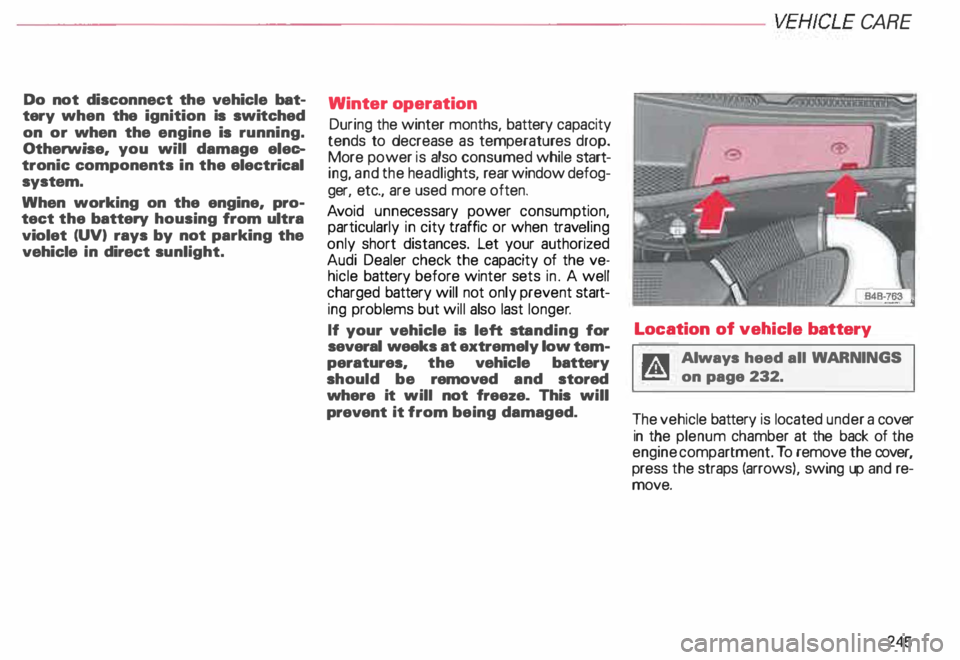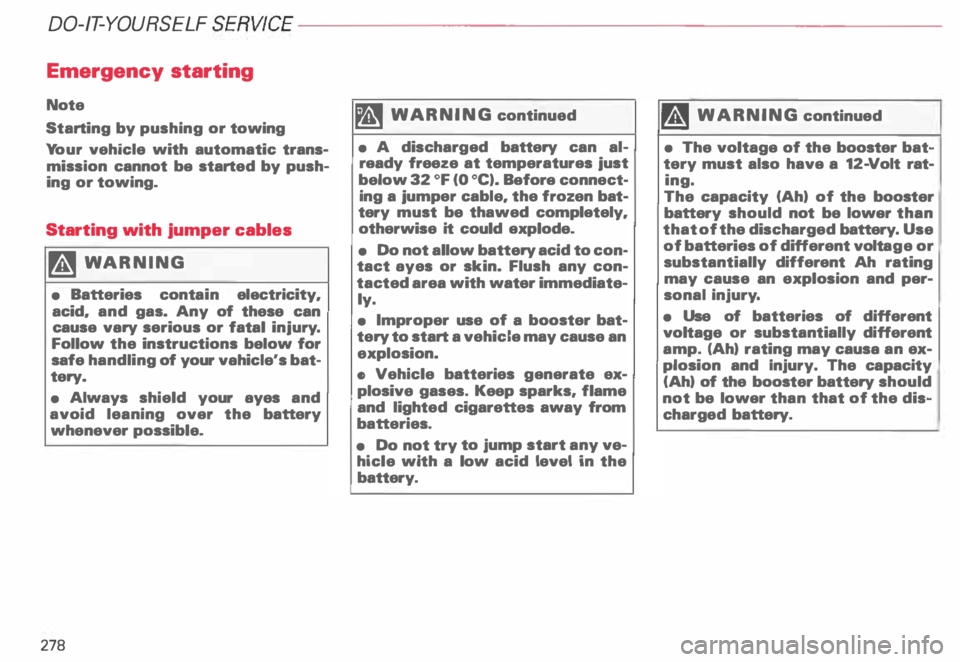2000 AUDI ALLROAD battery capacity
[x] Cancel search: battery capacityPage 246 of 306

-------------------------VEHICL E CA RE
Do not disconnect the vehicle bat
tery when the ignition is switched
on or when the engine is running.
Otherwise, you will damage elec
tronic components in the electrical
system.
When working on the engine, pro
tect the battery housing from ultra
violet (UV) rays by not parking the
vehicle in direct sunlight. Winter
operation
During the winter months, battery capacity
tends to decrease as temperatures drop.
More power is also consumed while start
ing, and the headli ghts, rear window defog
ger, etc., are used more often.
Av oid unne cessary power consumption,
particularly in city traffic or when trave:ling
only short distances. Let your authonzed
Audi Dealer check the capacity of the ve
hicle battery before winter sets in. A well
charged battery will not only prevent start
ing problems but will also last longer.
If your vehicle is left standing for
several weeks at extremely low tem
peratures, the vehicle battery
should be removed and stored
where it will not freeze. This will
prevent it from being damaged. Location
of vehicle battery
g Always heed all WAR NINGS
� on page 232.
The vehicle battery is located under a cover
in the plenum chamber at the back of the
engine compartment. To remove the cover,
press the straps (arrows ), swing up and re
move.
245
Page 248 of 306

f4 WARNING
continued
• Never charge a frozen battery. It
may explode because of gas
trapped in the ice. Allow a frozen
battery to thaw out first.
• Do not reuse batteries which
have fr ozen. The baUery housing
may have cracked and weakened
when the battery froze.
Always heed all WA RNINGS
on page 232.
• Battery acid that may spill during
charging should be washed off with
a solution of warm water and baking
soda to neutralize the acid.
• Never use a fast charger as a boo
ster to start the engine. This will se
riously damage sensitive electronic
components, such as control units,
relays, radio, etc., as well as the bat
tery charger. Slow
battery charging
�W ARNING
Heed all WA RNINGS and follow in
structions that come with your
battery charger.
• Before charging the battery, switch off
the ignition and all electrical consumers.
• Make sure the area is well ventilated
when you charge the battery.
• It is not necessary to remove the battery
from the engine compartment, and it is also
not necessary to disconn ect the cables.
• Make sure the electrolyte level in each
cell is between the .. min" and "max ..
marks. If the fluid level is below the "min"
mark, let your authorized Audi Dealer cor
rect the condition. VE
HICLE CARE
• Conne ct charger cables.
Charger cables must be connected
POSITIVE (+ ) to POSITIVE (+ ) and
NEGATIVE (-) to NEGATIVE (-).
�W ARNING
To reduce the danger of explosion,
never connect or disconnect char
ger cables while the charger is op
erating.
• Switch on charger.
• Charging rate not over 6 amps.
Normal ly, a battery should be charged at no
more than 1 0 percent of its rated capacity.
For example, a charging current of 4.5 amps
would be used on a battery rated at 45 Ah.
Rated capacity of the battery in your vehicle
is listed on the battery housing.
• After charging, first turn off the charger
and then disconnect charger cables. g Always heed all WARNINGS
� on page 232.
247
Page 279 of 306

DO-IT-Y
OURSELF SERVICE----------------------
Emergency starting
Note
Starting by pushing or towing
Yo ur vehicle with automatic trans
mission cannot be started by push
ing or towing.
Star ting with jumper cables
�W ARNING
• Batteries contain electricity.
acid. and gas. Any of these can
cause vary serious or fatal injury.
Follow the instructions below for
safe handling of your vahicle"s bat·
tery.
• Always shield your ayes and
avoid leaning over the battery
whenever possible.
278 �,
WAR NING continued
• A discharged battery can al
ready freeze at temperatures just
below 32 °F (0 °C). Before connect·
ing a jumper cable. the frozen bat
tery must be thawed completely.
otherwise it could explode.
• Do not allow battery acid to con·
tact ayes or skin. Flush any con
tacted area with water immediate
ly.
• Improper use of a booster bat
tery to start a vehicle may cause an
explosion.
• Vehicle batteries generate ex
plosive gases. Keep sparks. flame
and lighted cigarettes away from
batteries.
• Do not try to jump start any ve
hicle with a low acid level in the
battery. ,Al
WARNING continued
• The voltage of the booster bat
tery must also have a 12- Volt rat
ing.
The capacity (Ah) of the booster
battery should not be lower than
that of the discharged battery. Use
of batteries of different voltage or
substantially different Ah rating
may cause an explosion and per
sonal injur y.
• Use of batteries of different
voltage or substantially different
amp. (Ah) rating may causa an ex
plosion and Injury. The capacity
(Ah) of the booster battery should
not be lower than that of the dis
charged battery.
Page 304 of 306

----------------------------------------------ALPHABETICAL
INDEX
-T echnical requiremen ts . . . 208
-li ps ........ ....... ... •.. .21 1
-T railer brakes .. .". . . . . . • . . 209
Tra nsporting heavy objects . . . . . . 88
fr ip computer . . . . . . . . .
. 146
Tr ip odometer . • . . . . • • .
. . 12 0
Tu rn signals .. .. .. .. . . ..
125, 156
u
Under coating ......... .
Unfast ening-Safety belt ..
Uni versal Transmi tter .. .
Unleaded fuel ...
Unp aved roads .
v
V- belt .. 19
8, 220
. . . . . 24
17 3
225 19 9
.. .. 249
Va let key .
Ve hicle battery .
Ve hicle care .
... ... ... ..... 56
245
- Exterior . . . . • • • • . . . • • . . . . • 212
- Interior · .. ..• .. ... ... ... .. . 217
-W indows . • • . . . . . . • . . . . 215 Vehicle
identification . . . . 290
Ve hicle identi fication label . .
291
Vehicle identification number . .
290
Vehicle jack . . . . . . . . . . . . .
265
Vehicle literature . . . • . . • • • • . . . . 2
Ventilati on . . . . . . . . . . . . • • • . . . 16
2
Vo ltage warning label ..• .. .... 291
Vo ltmeter 120
w
Warning and indicator lights . . . . . 1 0
Warn ing lights . . . . . . . . . . . . 1 0, 122
Warning I in dicator lights
- Airbag system . . . . . . . . . . . 125
- Anti-lock brake system . . . . . 125
- Battery voltage . . . . . . . . . . . . 143
-B rake.. ........ • • . . . . .
126
- Brake light . . . . . 141
- Brake pads worn
. . . . . • . 14
3
- Coolant level . . . . . .
. . .
141
- Coolant temperature 141
- Electronic power control . . . . 123
- Engine oil level . . . . . . . . . . . . 144
- Engine oil pressure . . . . . . . . . 143 -F
uel . . . . . . • • •• • . . • 143
- Gener ator 127
- Headlights I tail lights . . . . . . . 143
- High beam . . . . . . . . .
125
-M alfunction Indicator Lamp . 125
- Safety belts . . . . . . . . . . . . . . 127
- Speed warning . . . . • • • • 14
4
- Turn signals . . . . . •
125
-W asher fluid . . . • . . • • • • . . . 14
3
Warranty booklet . . . .. . . • . . . . . . 4
Was her reservoir . . . . . . . . . . . . 250
Washer system . . . . • . . . • . • . .. . . 16 0
Wheels ........... .... .. .. 252
Wheels replacement . . . . . . 255, 259
Window s.......... . • ... .. 69
- Cleaning . . . . . . . . . • . • • . . . . . 215
- Defrosting . . . . . . .
163
Wi ndshield washer container . . . 250
- Capacity . . . . . .
287
Wi oter operation
- Battery . . . . . . .
245
- Cooling system . . . .
238
- Snow chains 261
-T ires ...... .
- Ve hicle care 260
213
303